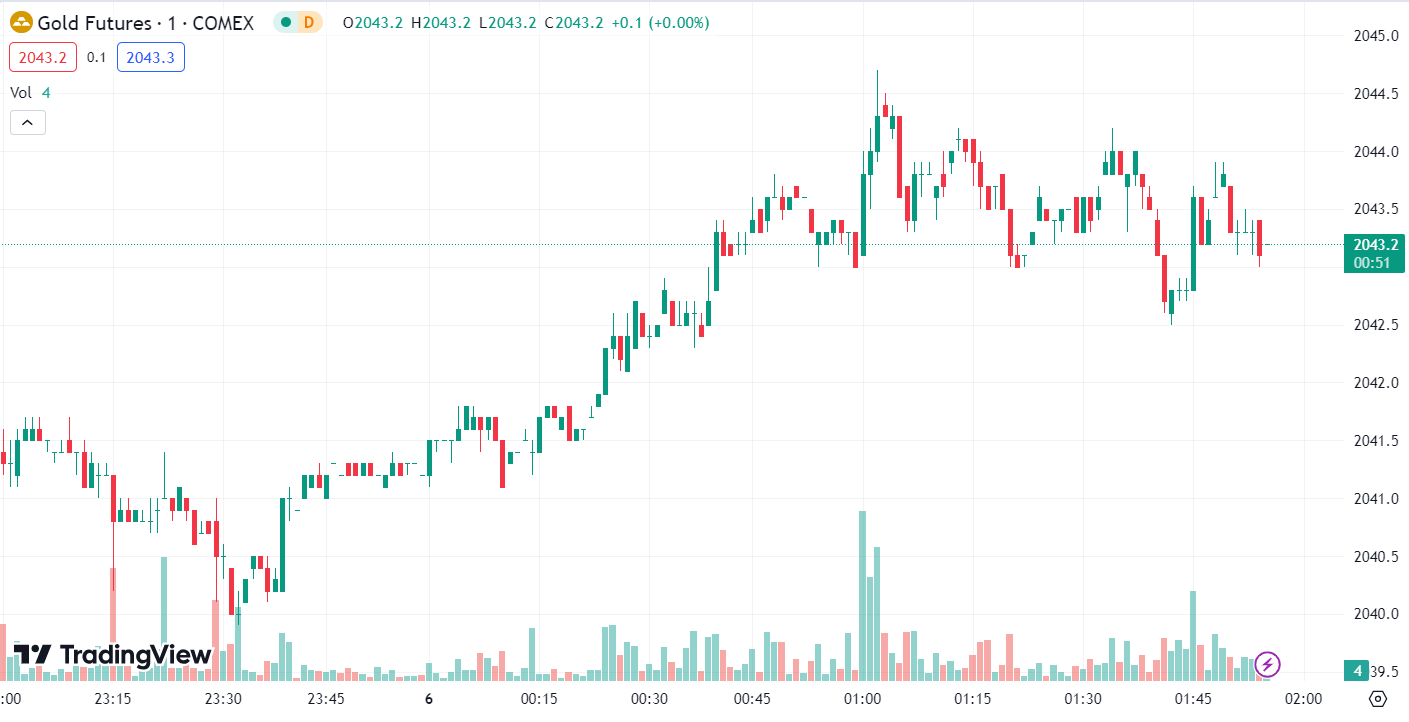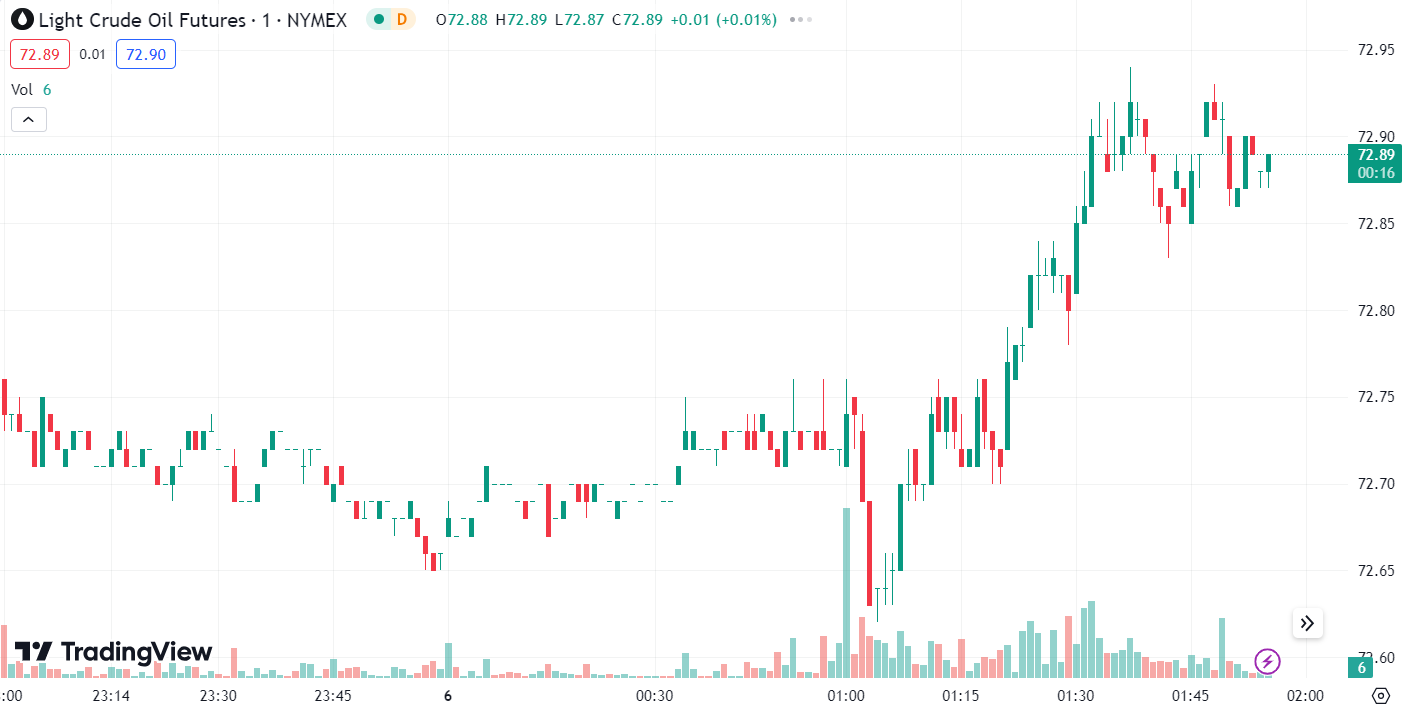
In January, the growth of the service industry in the United States accelerated, further reducing the possibility of interest rate cuts in March, once again dampening the bullish sentiment on gold.
The price of gold fell for the second consecutive trading day, dropping below the USD 2020 mark at one point; as the market worried about reduced global crude oil supply, oil prices rose by about USD 1.
Gold >>
On Monday, the accelerated growth of the service industry in the United States in January further reduced the possibility of interest rate cuts in March, once again suppressing the bullish sentiment on gold.
The price of gold fell for the second consecutive trading day, dropping below the USD 2020 mark to USD 2014.78 per ounce at one point, before narrowing its decline and closing at USD 2024.92 per ounce; COMEX gold fell by 0.59%, closing at USD 2041.6 per ounce.
The latest data released on Monday showed that input prices rose to an 11-month high due to increased new orders and a rebound in employment, but suppliers seemed to lag behind.
In addition to the surge in employment in January, the report also indicated that the momentum of economic growth since the fourth quarter continued into the new year.
Due to the strong economy, Federal Reserve officials will cautiously decide when to cut interest rates. According to the CME FedWatch Tool, traders currently estimate a 65% probability of a rate cut in May, while the probability of a rate cut in March has dropped to 16%.
Gold faced pressure at the USD 2042 level once again, encountering resistance and falling unilaterally.
Throughout the day, the opening high point steadily declined, with a rapid rebound around the USD 2028 level before weakly breaking through and accelerating downward during the US trading session, finally breaking through the USD 2015 level and closing with volatile movements.
Technical Analysis:

Today’s short-term strategy for gold suggests prioritizing short positions during rebounds, with long positions considered as a secondary approach during pullbacks.
- Key resistance levels to watch in the short term are around 2035-2040.
- Key support levels to watch in the short term are around 2010-2005.
WTI Crude Oil >>
On Monday, concerns in the market about tensions in the Middle East and the ongoing Russia-Ukraine conflict potentially suppressing global crude oil supply pushed WTI crude oil prices above USD 72 per barrel.
Eventually closing up by 0.6% at USD 72.74 per barrel; Brent crude oil briefly reached USD 78 per barrel during trading, ending the day with a 0.74% increase at USD 77.96 per barrel.
Currently, subdued market demand remains a significant factor restraining upward movement in oil prices, while the ceasefire agreement in Gaza could alleviate expectations regarding navigation issues in the Red Sea, but still serves as a drag on oil prices.
On the other hand, the decline in active drilling rigs in OPEC countries in December increases the likelihood of production cuts being implemented in the first quarter.
Although there hasn’t been a significant decrease in OPEC’s crude oil exports in January compared to December of last year, monitoring overall OPEC production in January is necessary to verify the implementation of production cuts.
Oil prices experienced fluctuations in technical aspects, initially pressured during the Asian and European sessions with weak oscillations below the USD 72.7 level, continuously falling.
During the evening US session, there were two unsuccessful attempts to rebound, with pressure at the USD 72.5 level, leading to a second dip.
Eventually, in the early morning, prices stabilized around the USD 71.4 level, followed by a bullish rebound with deep V-shaped oscillations, breaking through and stabilizing above the USD 72.5 level, near the opening decline level of the Asian session, and continuing to strengthen towards the USD 73.2 level before a retracement and volatile closing.
Technical Analysis:

Today’s crude oil trading strategy suggests prioritizing short positions during rebounds, with long positions considered as a secondary approach during pullbacks.
- Key resistance levels to monitor in the short term are around 74.0-74.5.
- Key support levels to monitor in the short term are around 71.5-71.0.
Forward-looking Statements
This article contains “forward-looking statements” and may be identified by the use of forward-looking terminology such as “anticipate”, “believe”, “continue”, “could”, “estimate”, “expect”, “hope”, “intend”, “may”, “might”, “plan”, “potential”, “predict”, “should”, or “will”, or other variations thereon or comparable terminology. However, the absence of such terminology does not mean that a statement is not forward-looking. In particular, statements about the expectations, beliefs, plans, objectives, assumptions, future events, or future performance of Doo Prime will be generally assumed as forward-looking statements.
Doo Prime has provided these forward-looking statements based on all current information available to Doo Prime and Doo Prime’s current expectations, assumptions, estimates, and projections. While Doo Prime believes these expectations, assumptions, estimations, and projections are reasonable, these forward-looking statements are only predictions and involve known and unknown risks and uncertainties, many of which are beyond Doo Prime’s control. Such risks and uncertainties may cause results, performance, or achievements materially different from those expressed or implied by the forward-looking statements.
Doo Prime does not provide any representation or warranty on the reliability, accuracy, or completeness of such statements. Doo Prime is not obliged to provide or release any updates or revisions to any forward-looking statements.
Disclaimer
While every effort has been made to ensure the accuracy of the information in this document, DOO Prime does not warrant or guarantee the accuracy, completeness or reliability of this information. DOO Prime does not accept responsibility for any losses or damages arising directly or indirectly, from the use of this document. The material contained in this document is provided solely for general information and educational purposes and is not and should not be construed as, an offer to buy or sell, or as a solicitation of an offer to buy or sell, securities, futures, options, bonds or any other relevant financial instruments or investments. Nothing in this document should be taken as making any recommendations or providing any investment or other advice with respect to the purchase, sale or other disposition of financial instruments, any related products or any other products, securities or investments. Trading involves risk and you are advised to exercise caution in relation to the report. Before making any investment decision, prospective investors should seek advice from their own financial advisers, take into account their individual financial needs and circumstances and carefully consider the risks associated with such investment decision.